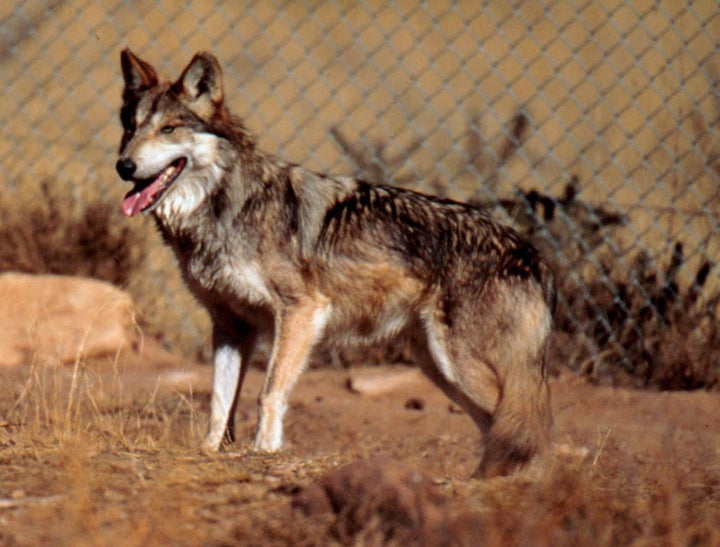
Is the endangered gray wolf on its way back?
A plan by Mexican wildlife officials to reintroduce a rare species of gray wolf to its historic range in northern Mexico has prompted questions from wildlife managers and ranchers in the Southwest, where a similar, decade-long effort has been fraught with controversy.
The U.S. Fish and Wildlife Service and officials with the Arizona Department of Game and Fish recently learned of the plan by the Mexican government to release five captive-bred Mexican gray wolves at an undisclosed ranch in northeastern Sonora.
Mexican officials on Tuesday were still working on finding a suitable date for the release, said Laura Aguilar, a spokeswoman for the Mexican agency that oversees natural resources and the environment.
The plan was first proposed in 2009 but has faced delays.
Now, with the release imminent, Arizona wildlife managers are scrambling to determine what effects it could have on the effort in Arizona and New Mexico to reintroduce the endangered wolf.
"Obviously, there are some implications for our reintroduction program here if those wolves come across. It doesn't necessarily mean it's a bad thing or a good thing, but we just need to have some answers to our questions," said Lynda Lambert, a spokeswoman for the Arizona Game and Fish Department.
Wildlife managers and ranchers in the two states want to know whether the wolves will be protected under the federal Endangered Species Act. Or will they have the same "nonessential, experimental" designation as wolves released as part of the reintroduction effort in New Mexico and Arizona?
There are also questions about how the wolves will be detected and monitored if they cross the international border, and how nuisance and livestock depredation incidents in the U.S. will be investigated if they involve the wolves from Mexico.
"When this came up two years ago, we raised some questions that really were never answered and so now I guess we start over again," said Caren Cowan, executive director of the New Mexico Cattle Growers Association. "There's a lot of concern because there's a lot of stuff we just don't know."
Cowan added that ranchers she has talked to in Sonora are concerned after having seen the challenges spurred by the U.S. reintroduction effort.
Environmentalists said a release in Mexico would help ensure the species' recovery in both countries.
The effort to return the wolves to the wild in New Mexico and Arizona has been hampered by illegal shootings, court battles, complaints from ranchers who have lost livestock and pets to the wolves, and concerns by environmentalists over the way the reintroduction program has been managed.
The Mexican wolf, a subspecies of the gray wolf, was exterminated in the wild in the Southwest by the 1930s after a campaign by the federal government to control the predator.
A handful of wolves were captured in Mexico in the late 1970s to save the animal from extinction. In 1998, the U.S. government began reintroducing wolves along the Arizona-New Mexico line in a 4 million-acre territory.
Biologists had hoped to have at least 100 wolves by now, but the latest survey shows about half that number.
It's unclear how many wolves are in Mexico's Sonora state, but the U.S. Fish and Wildlife Service said Mexico has 18 captive-breeding facilities and 66 wolves.
Michael Robinson of the Center for Biological Diversity called the prospect of wolves in the Mexican wild "extraordinarily good news." He said it's critical that the Sierra Madre range in Mexico be identified as part of the wolf recovery area.
"It's hard to conceive of recovery actually taking place without a population of wolves sustaining itself in Mexico and being connected to those in the United States," he said.
Both Robinson and Tom Buckley, a spokesman for the Fish and Wildlife Service, said connectivity between the two populations would help broaden the wolf's genetic pool.
"As they expand, we want to see them mix, we want to see them naturally have that genetic exchange," Buckley said. "That's one of the hopes in order for them to become a self-sustaining larger population."
Officials said the wolves that will be released in Mexico will be fitted with radio collars so they can be monitored.
If they cross the border, the Fish and Wildlife Service said they will have the full protection of the federal Endangered Species Act as long as they are outside the boundaries of the wolf recovery area that spans southeastern Arizona and southwestern New Mexico.
If the wolves are found within the recovery area, they will be considered as part of the experimental population -- a classification that gives wildlife officials greater flexibility in managing the animals.
Despite the concerns of ranchers in Mexico and the American Southwest, Buckley said Mexico is a sovereign nation with its own conservation laws and programs.
"It's Mexico's choice," he said. "They can make their own call."
Mexico has spelled out its priorities for protecting the wolf in a 52-page action plan that covers everything from identifying suitable reintroduction sites to involving the public in the effort. The wolf is one of 30 at-risk species for which the country hopes to implement conservation plans for by 2012.
Read more from Fox News Latino and be sure to check out Check out the slideshow here.